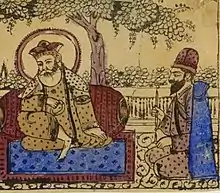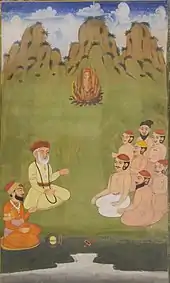Bhai Bala | |
|---|---|
ਭਾਈ ਬਾਲਾ | |
 Bhai Bala seated to the right of Nanak | |
| Personal | |
| Born | Bala Sandhu 1466 Rai-Bhoi-Di-Talwandi, Punjab |
| Died | 1544 Khadur Sahib |
| Cremation place | Precincts of the modern Gurdwara Tapiana Sahib |
| Religion | Hinduism (birth) Sikhism (convert) |
| Parent |
|


Bhai Bala (Punjabi: ਭਾਈ ਬਾਲਾ 1466–1544), born in Talwandi Rai Bhoi into a Sandhu Jat family[1] (now called Nankana Sahib in Pakistan),[2][3] was a childhood friend and lifelong companion of Bhai Mardana and Guru Nanak. According to the Bhai Bala Janam Sakhis, he traveled with Guru Nanak and Bhai Mardana on all of their great journeys around the world including China, Mecca, and around India. He supposedly died in Khadur Sahib, in his late 70s, in 1544.[2][4]
Historicity
There has been considerable discussion as regards to Bhai Bala's existence, particularly within the Sikh academic field. The reasons for this are:
Bhai Gurdas, who has listed all Guru Nanak's prominent disciples (in his 11th Var), does not mention the name of Bhai Bala (this may be an oversight, for he does not mention Rai Bular either). However Bhai Mani Singh's Bhagat Ratanwali, which contains essentially the same list as that by Bhai Gurdas, but with more detail, also does not mention Bhai Bala.[5] There are a number of other anomalies, which Dr. Kirpal Singh has explicated in his Punjabi work 'Janamsakhi Tradition.'[6][7]
Dr. Trilochan Singh counters some of the points raised by stating that Mehma Parkash and Mani Singh Janamsakhi both mention Bhai Bala. Bala is further mentioned in Suchak Prasang Guru Ka by Bhai Behlo written during Guru Arjan Dev’s time. Bhai Behlo says, “Bala discarded his body there, At the holy city of Khadaur, Angad, the master, preformed the rites, Graciously with his own two hands.” He also raises the point that Bhai Bala’s family is still living in Nankana Sahib and that Bala’s samadhi exists in Khadaur.[8] According to H.S. Singha, some scholars argue that Bhai Bala was a genuine person, however his Janamsakhi hagiographies had been corrupted by heretical sects such as the Minas, Handaliyas, and others.[9] The earliest extant Bala version rendition of the Janamsakhis itself claims to date to 1525 but this has been refuted by W.H. McLeod.[10]
See also
References
- ↑ McLeod, W. H. (1980). Early Sikh tradition : a study of the janam-sākhīs. Oxford: Clarendon Press. p. 15. ISBN 0-19-826532-8. OCLC 5100963.
- 1 2 McLeod, W.H., Guru Nanak and the Sikh Religion. Oxford, 1968.
- ↑ A Gateway to Sikhism | Early Gursikhs: Bhai Bala Ji - A Gateway to Sikhism
- ↑ Max Arthur Macauliffe, 1909
- ↑ Singh, Bhupender (23 December 2022). Baba Nanak Shah Fakir (1st ed.). Blue Rose Publishers. p. 23. ISBN 9789357046602.
4. Bhagat/Gyan Ratnavali by Mani Singh: This work was written around the eighteenth century (between AD 1675 and 1708) by Bhai Mani Singh, a devotee of Guru Gobind and is only an exposition of Bhai Gurdas's first canto. It does not pretend to add to the information on Guru Nanak. Historic value of Bhagat Ratnavali is immense because it is based on the first Var of Bhai Gurdas and contains no imaginary events. Also, it records all episodes in chronological order and avoids errors of other janamsakhis. Bhagat Ratnavali is significant, in the sense that in the list of Guru Nanak's companions and disciples, contained in this book there is no mention of Bala Sandhu.
- ↑ Singh, Dr Kirpal, Janamsakhi Tradition (An Analytical Study). Singh Brothers, 2004.(page 10)
- ↑ Dr. Kirpal Singh. "Janamsakhi Tradition – An Analytical Study" (PDF). Archived from the original (PDF) on 1 March 2012. Retrieved 8 September 2012.
- ↑ Singh, Dr. Trilochan. Guru Nanak: Founder of Sikhism: A Biography (PDF). pp. 492–494.
- ↑ Singha, H.S. (2000). The Encyclopedia of Sikhism. p. 28. ISBN 9788170103011. Retrieved 19 August 2022.
- ↑ McLeod, W. H. (1980). Early Sikh tradition : a study of the janam-sākhīs. Oxford: Clarendon Press. p. 16. ISBN 0-19-826532-8. OCLC 5100963.